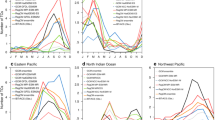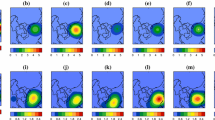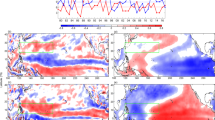Abstract
Tropical cyclones (TCs) over the western North Pacific (WNP) are simulated for the 29 TC seasons of July–October from 1982 to 2010 using the regional Weather Research and Forecasting (WRF) model nested within global WRF model simulations. Averaged over the entire 29-year period, the nested global–regional WRF has reasonably simulated the climatology of key TC features such as the location/frequency of genesis and tracks. The dynamical and thermal structures of the simulated TCs are weaker than observations owing to the coarse spatial resolution of the regional WRF (50 km × 50 km). TC frequencies are somewhat underestimated over the East China Sea but are substantially overestimated over the South China Sea and the Philippine Sea with neighboring oceans between 10°N and 15°N. Categorization of the simulated TCs into six clusters based on the observed TC clusters and the associated large-scale circulation show that the nested simulation depicts the observed TC characteristics well except for two clusters associated with TCs traveling from the Philippine Sea to the East China Sea. Errors in the simulated TC genesis and tracks are mostly related to these two clusters. In the simulation, the monsoon confluent zone over the Philippine Sea is too strong, and the mid-latitude jet stream expands farther south than that in the observations. Overall results from this study suggest that the nested global–regional WRF can be useful for studying the TC climatology over the WNP.






Similar content being viewed by others
References
Au-Yeung AYM, Chan JCL (2011) Potential use of a regional climate model in seasonal tropical cyclone activity predictions in the western North Pacific. Clim Dyn 39:783–794
Bender MA, Ginis I (2000) Real-case simulations of hurricane–ocean interaction using a high-resolution coupled model: effects on hurricane intensity. Mon Weather Rev 128:917–946
Bender MA, Ginis I, Kurihara Y (1993) Numerical simulations of tropical cyclone–ocean interaction with a high-resolution coupled model. J Geophs Res 98:23245–23263
Bengtsson L, Hodges KI, Esch M, Keenlyside N, Kornblueh L, Luo J-J, Yamagata T (2007) How may tropical cyclones change in a warmer climate? Tellus A 59:539–561
Bensaid AM, Hall LO, Bezdek JC, Clarke LP, Silbiger ML, Arrington JA, Murtagh RF (1996) Validity-guided (re)clustering with applications to image segmentation. IEEE Trans Fuzzy Syst 4:112–123
Bezdek JC (1981) Pattern recognition with fuzzy objective function algorithms. Kluwer Academic, Dordrecht 256
Briegel LM, Frank WM (1997) Large-scale influences on tropical cyclogenesis in the western north Pacific. Mon Weather Rev 125:1397–1413
Camargo SJ, Sobel AH (2005) Western North Pacific tropical cyclone intensity and ENSO. J Clim 18:2996–3006
Camargo SJ, Li H, Sun L (2007a) Feasibility study for downscaling seasonal tropical cyclone activity using the NCEP regional spectral model. Int J Clim 27:311–325
Camargo SJ, Robertson AW, Gaffney SJ, Smyth P, Ghil M (2007b) Cluster analysis of typhoon tracks. Part I: General properties. J Clim 20:3635–3653
Camargo SJ, Robertson AW, Gaffney SJ, Smyth P, Ghil M (2007c) Cluster analysis of typhoon tracks. Part II: large-scale circulation and ENSO. J Clim 20:3654–3676
Cha D-H, Jin C-S, Lee D-K, Kuo Y-H (2011) Impact of intermittent spectral nudging on regional climate simulation using Weather Research and Forecasting model. J Geophs Rev 116. doi:10.1029/2010jd015069
Chan JCL (2000) Tropical cyclone activity over the western North Pacific associated with El Nino and La Nina events. J Clim 13:2960–2972
Chen F, Dudhia J (2001) Coupling an advanced land surface-hydrology model with the Penn State-NCAR MM5 modeling system. Part I: model implementation and sensitivity. Mon Weather Rev 129:569–585
Collins WD, Rasch PJ, Boville BA, Hack JJ, McCaa JR, Williamson DL, Kiehl JT, Briegleb B, Bitz C, Lin S-J, Zhang M, Dai Y (2004) Description of the NCAR Community Atmosphere Model (CAM 3.0), NCAR Tech. Note. NCAR Tech. Note 226
Davis C, Wang W, Chen SS, Chen Y, Corbosiero K, DeMaria M, Dudhia J, Holland G, Klemp J, Michalakes J, Reeves H, Rotunno R, Snyder C, Xiao Q (2008) Prediction of landfalling hurricanes with the advanced hurricane WRF model. Mon Weather Rev 136:1990–2005
DeMaria M (1996) The effect of vertical shear on tropical cyclone intensity change. J Atmos Sci 53:2076–2087
Done JM, Holland GJ, Webster PJ (2011) The role of wave energy accumulation in tropical cyclogenesis over the tropical North Atlantic. Clim Dyn 36:753–767
Dunn JC (1973) A fuzzy relative of the ISODATA process and its use in detecting compact well-separated clusters. J Cybernet 3:32–57
Elsner JB, Liu KB (2003) Examining the ENSO-typhoon hypothesis. Clim Res 25:43–54
Fierro AO, Rogers RF, Marks FD, Nolan DS (2009) The impact of horizontal grid spacing on the microphysical and kinematic structures of strong tropical cyclones simulated with the WRF-ARW model. Mon Weather Rev 137:3717–3743
Frank WM (1977) Structure and energetics of tropical cyclone I. Storm structure. Mon Weather Rev 105:1119–1135
Gentry MS, Lackmann GM (2010) Sensitivity of simulated tropical cyclone structure and intensity to horizontal resolution. Mon Weather Rev 138:688–704
Gray WM (1977) Tropical cyclone genesis in the western North Pacific. Meteorol Atmos Phys 55:465–482
Harr PA, Elsberry RL (1991) Tropical cyclone track characteristics as a function of large-scale circulation anomalies. Mon Weather Rev 119:1448–1468
Ho CH, Baik JJ, Kim JH, Gong DY, Sui CH (2004) Interdecadal changes in summertime typhoon tracks. J Clim 17:1767–1776
Ho C-H, Kim H-S, Jeong J-H, Son S-W (2009) Influence of stratospheric quasi-biennial oscillation on tropical cyclone tracks in the western North Pacific. Geophys Res Lett 36. doi:10.1029/2009gl037163
Hodanish S, Gray WM (1993) An observational analysis of tropical cyclone recurvature. Mon Weather Rev 121:2665–2689
Hong SY, Dudhia J, Chen SH (2004) A revised approach to ice microphysical processes for the bulk parameterization of clouds and precipitation. Mon Weather Rev 132:103–120
Hong SY, Noh Y, Dudhia J (2006) A new vertical diffusion package with an explicit treatment of entrainment processes. Mon Weather Rev 134:2318–2341
Jin C-S, Ho C-H, Kim J-H, Lee D-K, Cha D-H, Yeh S-W (2013) Critical role of northern off-equatorial sea surface temperature forcing associated with central pacific El Niño in more frequent tropical cyclone movements toward east Asia. J Clim 26:2534–2545
Kain JS, Fritsch JM (1990) A one-dimensional entraining detraining plume model and its application in convective parameterization. J Atmos Sci 47:2784–2802
Kanamitsu M, Ebisuzaki W, Woollen J, Yang S-K, Hnilo JJ, Fiorino M, Potter GL (2002) NCEP–DOE AMIP-II reanalysis (R-2). Bull Am Meteorol Soc 83:1631–1643
Kepert JD (2006a) Observed boundary layer wind structure and balance in the hurricane core. Part I: Hurricane Georges. J Atmos Sci 63:2169–2193
Kepert JD (2006b) Observed boundary layer wind structure and balance in the hurricane core. Part II: hurricane Mitch. J Atmos Sci 63:2194–2211
Kim JH, Ho CH, Sui CH (2005a) Circulation features associated with the record-breaking typhoon landfall on Japan in 2004. Geophys Res Lett 32. doi:10.1029/2005gl022494
Kim JH, Ho CH, Sui CH, Park SK (2005b) Dipole structure of interannual variations in summertime tropical cyclone activity over East Asia. J Clim 18:5344–5356
Kim J-H, Ho C-H, Kim H-S, Sui C-H, Park SK (2008) Systematic variation of summertime tropical cyclone activity in the western North Pacific in relation to the Madden–Julian Oscillation. J Clim 21:1171–1191
Kim H-S, Kim J-H, Ho C-H, Chu P-S (2011) Pattern classification of typhoon tracks using the fuzzy c-means clustering method. J Clim 24:488–508
Kim J, Waliser DE, Mattmann CA, Goodale CE, Hart AF, Zimdars PA, Crichton DJ, Jones C, Nikulin G, Hewitson B, Jack C, Lennard C, Favre A (2013) Evaluation of the CORDEX-Africa multi-RCM hindcast: systematic model errors. Clim Dyn. doi:10.1007/s00382-013-1751-7
Manganello JV, Hodges KI, Kinter JL, Cash BA, Marx L, Jung T, Achuthavarier D, Adams JM, Altshuler EL, Huang B, Jin EK, Stan C, Towers P, Wedi N (2012) Tropical cyclone climatology in a 10-km hlobal atmospheric GCM: toward weather-resolving climate modeling. J Clim 25:3867–3893
Mearns LO, Arritt R, Biner S, Bukovsky MS, McGinnis S, Sain S, Caya D, Correia J, Flory D, Gutowski W, Takle ES, Jones R, Leung R, Moufouma-Okia W, McDaniel L, Nunes AMB, Qian Y, Roads J, Sloan L, Snyder M (2012) The north American regional climate change assessment program overview of phase I results. Bull Am Meteorol Soc 93:1337–1362
Nakamura J, Lall U, Kushnir Y, Camargo SJ (2009) Classifying north Atlantic tropical cyclone tracks by mass moments. J Clim 22:5481–5494
Oouchi K, Yoshimura J, Yoshimura H, Mizuta R, Kusunoki S, Noda A (2006) Tropical cyclone climatology in a global-warming climate as simulated in a 20 km-mesh global atmospheric model: frequency and wind intensity analyses. J Meteorol Soc Jpn 84:259–276
Park DSR, Ho CH, Kim JH (2014) Growing threat of intense tropical cyclones to East Asia over the period 1977–2010. Environ Res Lett 9:Artn 014008. doi:10.1088/1748-9326/9/1/014008
Potty J, Oo SM, Raju PVS, Mohanty UC (2012) Performance of nested WRF model in typhoon simulations over West Pacific and South China Sea. Nat Hazards 63:1451–1470
Ray P, Zhang CD, Moncrieff MW, Dudhia J, Caron JM, Leung LR, Bruyere C (2011) Role of the atmospheric mean state on the initiation of the Madden–Julian Oscillation in a tropical channel model. Clim Dyn 36:161–184
Reynolds RW, Rayner NA, Smith TM, Stokes DC, Wang WQ (2002) An improved in situ and satellite SST analysis for climate. J Clim 15:1609–1625
Shin HH, Hong SY, Dudhia J, Kim YJ (2010) Orography-induced gravity wave drag parameterization in the global WRF: implementation and sensitivity to shortwave radiation schemes. Adv Meteorol Artn 959014. doi:10.1155/2010/959014
Skamarock WC, Kelmp JB, Gill DO, Barker DM, Duda MG, Huang XY, Wang W, Powers JG (2008) A description of the advanced research wrf version 3. NCAR Tech. Note NCAR/TN-475+STR:133
Skok G, Tribbia J, Rakovec J (2010) Object-based analysis and verification of WRF model precipitation in the low- and midlatitude Pacific Ocean. Mon Weather Rev 138:4561–4575
Stowasser M, Wang Y, Hamilton K (2007) Tropical cyclone changes in the western North Pacific in a global warming scenario. J Clim 20:2378–2396
Suzuki-Parker A (2011) An assessment of uncertainties and limitations in simulating tropical cyclone climatology and future changes. Ph.D. thesis Georgia Institute of Technology 78
Tulich SN, Kiladis GN, Suzuki-Parker A (2011) Convectively coupled Kelvin and easterly waves in a regional climate simulation of the tropics. Clim Dyn 36:185–203
Waliser D, Kim J, Xue Y, Chao Y, Eldering A, Fovell R, Hall A, Li Q, Liou KN, McWilliams J, Kapnick S, Vasic R, Sale F, Yu Y (2011) Simulating cold season snowpack: impacts of snow albedo and multi-layer snow physics. Clim Change 109:95–117
Walsh K, Lavender S, Murakami H, Scoccimarro E, Caron L-P, Ghantous M (2010) The tropical cyclone climate model intercomparison project. Hurricanes Clim Change 1–24
Wang B, Chan JCL (2002) How strong ENSO events affect tropical storm activity over the western North Pacific. J Clim 15:1643–1658
Wang Y, Wu CC (2004) Current understanding of tropical cyclone structure and intensity changes—a review. Meteorol Atmos Phys 87:257–278
Xie XLL, Beni G (1991) A validity measure for fuzzy clustering. Trans Pattern Anal Mach Intell 13:841–847
Acknowledgments
This work was funded by the Korea Meteorological Administration Research and Development Program under Grant CATER 2012–2040.
Author information
Authors and Affiliations
Corresponding author
Rights and permissions
About this article
Cite this article
Kim, D., Jin, CS., Ho, CH. et al. Climatological features of WRF-simulated tropical cyclones over the western North Pacific. Clim Dyn 44, 3223–3235 (2015). https://doi.org/10.1007/s00382-014-2410-3
Received:
Accepted:
Published:
Issue Date:
DOI: https://doi.org/10.1007/s00382-014-2410-3




